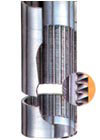
A stainless steel wedge-wire inline screen. Photo courtesy of Chemdex Chemicals.
Water well use represents a very small percentage of the production of steel tubular products. Practically all steel pipe manufactured worldwide falls into two categories:
- transmission (line) pipe for the conveyance of water, oil or gas
- oil country tubular goods, such as heavy wall tubing and drill pipe
Electric Resistance Welded
Generally, transmission pipe of diameters from 4 inches to 16 inches is produced by the electric resistance weld (ERW) process. First, raw material in coil form (skelp) is unrolled and flattened. The skelp then moves through a series of forming rolls, which, stage-by-stage, shape it into a cylinder. The seam is welded as it passes beneath rotating electrodes. Resistance encountered by the current at the seam edge heats the metal to a plastic state. Simultaneously, pressure is applied, forging the edges together. The pipe then travels through a series of finishing rolls. These stages reduce the diameter slightly, assuring proper size and roundness.Seamless
Oil country tubular goods are difficult to weld by ordinary procedures. These products and other special purpose pipe and tubing in diameters 20 inches and smaller usually are manufactured by the seamless process. A billet of steel is heated to a plastic state and pierced by a spear or lance. The hollow billet is gradually elongated as it is shaped over mandrils, and sized by rollers until pipe is produced. For water well applications, seamless pipe has no inherent advantage over welded pipe, and its higher cost usually is not justified.
Well screen selection has a tremendous impact on a well's maintenance and long-term performance. Photo courtesy of F.G. Driscoll.
Press Formed
A substantial portion of transmission pipe 18 inches in diameter and larger is manufactured by the press forming process. This method is a three-stage operation.In the first stage, the edges of a flat steel plate are curved upward. The plate then is pressed by dies into the shape of a “U.” In the final stage, a third press closes the “U” to form a cylinder. The seam then is welded by the submerged arc electric weld (SAW) process. SAW welding requires the use of a bare-wire electrode and a granular flux. Contact of the electrode and the seam to be welded creates an electric arc. As a welding head traverses the seam, wire and flux are continuously added. The function of flux is to shield the molten weld from atmospheric contamination and add alloys to the weld deposit. This process allows the weld puddle to be molten long enough to purge impurities. SAW welds are strong, ductile and uniform. Their mechanical properties are equal to or superior to those of the base metal.
Fabricated
Generally used for production of large-diameter pipe for special end uses, this process is non-continuous and multi-staged. Flat sheets or plates are first squared and sheared to the proper diameter requirements. In the second stage, longitudinal edges are preformed to the required pipe curvature. The steel then is driven between rolls, bending it into a cylinder. Seam welding is performed by the SAW process. Longer lengths, when required, are manufactured by welding together the necessary number of cylinders.Spiral Weld
A newer pipe manufacturing technology involves fabricating a spiral seam tube. Skelp is first flattened and then formed into a cylinder between rolls or a circular-shaped cage or shoe. The seam is welded at the first point of strip contact. Most spiral tubes today are welded from both the inside and outside, assuring full weld penetration. The spiral system is a continuous operation, and individual lengths are cut downstream of the producing equipment.The spiral process offers special advantages. Wall thickness varies according to the thickness of raw material. Since skelp adheres to very close tolerances, pipe manufactured by the spiral and electric resistance weld processes is more uniform and accurate in wall thickness than pipe produced by the seamless and press forming methods. Spiral pipe mils are flexible, enabling the manufacture of pipe from many grades of steel and non-ferrous weldable metals. Non-scheduled diameters and thicknesses can be produced economically for water well installations where required. Another virtue of this system of pipe manufacturing is high product roundness and straightness. Also beneficial is the greater strength of submerged arc electric welded seams. This results from the reinforcement of the weld, and the fact that hoop stresses in a spiral seam tube are less than those in a straight seam tube, due to the “bandage” effect and distributed forces.
Inherent in the spiral method is the ability to form high-strength, heavy-wall, large-diameter pipes currently required in the petroleum and gas industries. For that reason, most recently built facilities producing such products utilize this process.
This article series is provided through the courtesy of Roscoe Moss Co., a leading manufacturer of water well casings and screens.
Report Abusive Comment